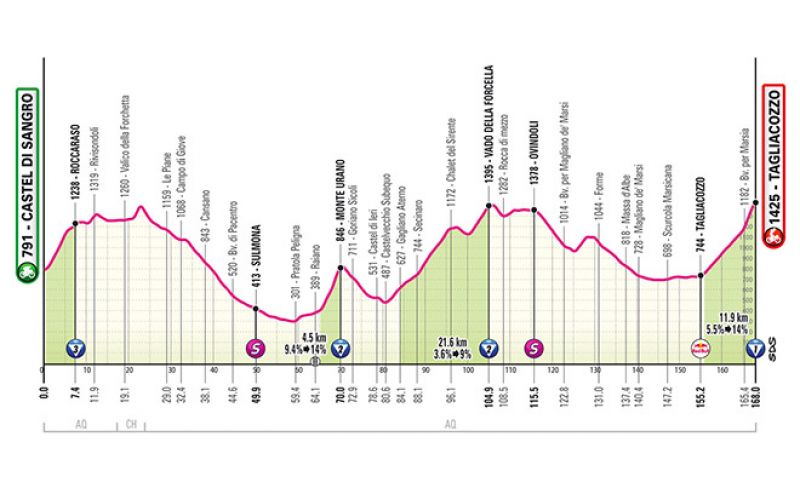

The seventh stage is one of the most anticipated in the first part of the Giro d'Italia because it will offer the first mountain finish and thus bring the general classification riders to the forefront. The route starts from Castel di Sangro and arrives in Tagliacozzo after 168 kilometers and four mountain passes.
to follow the live coverage of the entire stage starting at 12:50 PM CLICK HERE
First mountain finish and authentic Apennine stage with a continuous alternation of climbs and descents, sometimes short, sometimes long. It begins by climbing right from the start to reach Roccaraso, then comes the challenging climb of Monte Urano, short but with gradients up to 14%. Around kilometer 100, the Forcella Pass is tackled before arriving at the final climb that, past the town of Tagliacozzo, leads to the Marsia location where the finish is located.
The final ascent measures 11.9 km with an average gradient of 5.5% and in the last three kilometers it reaches up to 13%. The Giro will not be decided here, but considering also yesterday's difficult stage, we will certainly know more about the story of this edition of the pink race.
THE TERRITORY. Now in Abruzzo, Castel di Sangro preserves much of its ancient medieval layout, of which remarkable examples are the Basilica of Santa Maria Assunta, the jewel fraction of Roccacinquemiglia perched on a rocky spur, while the Ducal Castle, following numerous renovations, now shows a Renaissance appearance. Always balancing between past and present, this location today known for being an important production hub in the automotive sector, is also the cradle of Montepulciano d'Abruzzo, the red symbol of Abruzzo's wine production.
Immediately after the start, the seventh stage of the Giro tackles the short climb that leads to Roccaraso (equipped with a bike park) and Rivisondoli, today established and welcoming tourist resorts.
The next stage is Sulmona, the city of confetti and, for the less sweet-toothed, of the great Latin poet Ovid. Here a walk through the historic center is a must to visit the Cathedral of San Panfilo (11th century), the Annunziata complex, formed by the union of the Annunziata palace (from 1320) with the adjacent Annunziata church and, of course, the dozens of shops where you can stock up on confetti, to which even a Museum has been dedicated.
Then it's Pratola Peligna's turn to capture attention and bring the area's viticulture to the forefront: here Montepulciano d'Abruzzo finds a worthy rival in Trebbiano. To be tasted, however, only after a walk through the medieval historic center to the San Pietro Celestino square, the ancient heart of the town. In nearby Popoli, instead, the Cantelmo Castle is admired, built around the year 1000 on a rocky spur and the Ducal Palace (1440), which overlooks Piazza della Libertà where the cycling enthusiast can fill their water bottle at the historic Mascheroni Fountain.
In Rocca di Mezzo it's pleasant to discover the Borgo neighborhood ("Lu Bulvere"), the oldest part of the town and the Church of the Madonna della Neve, with the medieval tower built for defensive purposes and later converted to the more reassuring function of bell tower. Immediately after comes Ovindoli, one of the main winter sports resorts in Central Italy, which boasts an ancient and important history: a Marsic stronghold, it was destroyed by the Romans and many centuries later rebuilt by the Lombards. In 1268, Charles of Anjou stayed here before his victory over Conradin of Swabia.
The stage concludes in Tagliacozzo, but not in the heart of the town, rather 13 kilometers further up, at the 1200 meters of Monte Bove. Before tackling the decisive climb, it's worth taking a look at this Marsia center that has so much to tell and show. Among the most significant buildings, certainly the 15th-century Governorate Palace, the 16th-century Colonna Governor's Palace and the 17th-century Fallace Palace with its splendid loggia. The square was originally enclosed by a perimeter portico, whose arches were closed in the 1800s to create artisan shops and commercial spaces. The photo of the day, however, is taken in front of the Obelisk Fountain, with its Baroque forms, which this year celebrates its first 200 years.
